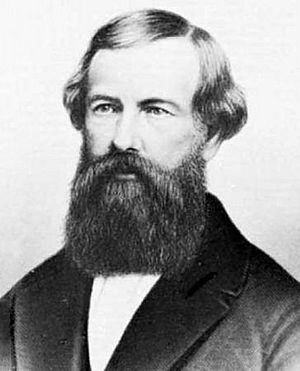Elisha Otis facts for kids
Quick facts for kids
Elisha Graves Otis
|
|
|---|---|

Elisha Graves Otis
|
|
| Born | August 3, 1811 Halifax, Vermont, United States
|
| Died | April 8, 1861 (aged 49) |
| Nationality | American |
| Occupation | Engineer |
| Spouse(s) | Susan Houghton, Elizabeth Otis |
| Children | Charles Rollin Otis, Norton Prentice Otis |
| Engineering career | |
| Projects | Elevators |
Elisha Graves Otis (born August 3, 1811 – died April 8, 1861) was an American inventor and business owner. He started the Otis Elevator Company. He is famous for inventing a special safety device. This device stops elevators from falling if their main cable breaks. His invention made elevators much safer and helped make tall skyscrapers possible!
Contents
Elisha Otis's Early Life
Elisha Otis was born in Halifax, Vermont. His parents were Stephen Otis and Phoebe Glynn. When he was 19, he left home. He moved to Troy, New York, and worked as a wagon driver for five years.
In 1834, Elisha married Susan A. Houghton. They had two sons, Charles and Norton. After getting very sick, Elisha moved his family to the Vermont Hills. He built his own gristmill (a mill for grinding grain). When that didn't make enough money, he changed it into a sawmill. He also started building wagons and carriages, which he was good at. Sadly, his wife Susan passed away later.
New Beginnings and Inventions
When Elisha was 34, he wanted a fresh start. He married again and moved to Albany, New York. He worked for a doll maker named Otis Tingely. Elisha was a skilled craftsman. He got tired of making only twelve toys a day by hand. So, he invented a "robot turner." This machine could make wooden bed frames four times faster! It could make about fifty a day. His boss was very impressed and gave him a bonus.
Elisha then started his own business. He began designing a safety brake for trains. He also worked on an automatic oven for baking bread. But his business had to close. The city of Albany changed the path of the stream he was using for power.
In 1851, he moved to Bergen City, New Jersey (now part of Jersey City). He worked there as a mechanic. Later, he moved to Yonkers, New York. He became the manager of an old sawmill. His job was to turn it into a factory for making bed frames.
How the Safety Elevator Changed Everything
When Elisha was 40, he was cleaning up the factory. He needed a way to lift heavy old materials to the upper floors. He knew about lifting platforms, but they were risky because they often broke. Elisha and his sons, who also loved to tinker, decided to build their own "safety elevator." They tested it, and it worked perfectly!
At first, Elisha didn't think his invention was a big deal. He didn't even try to get a patent or sell it. But after making a few sales, and as the bed frame factory slowed down, Otis saw a chance. He decided to start an elevator company. It was first called Union Elevator Works. Later, it became the famous Otis Brothers & Co..
The Famous World's Fair Demonstration
For several months, no one ordered any elevators. But then, the 1853 New York World's Fair offered a huge chance for publicity. At the New York Crystal Palace, Elisha Otis did something amazing. He stood on his elevator platform high above a crowd. Then, he told an axeman to cut the only rope holding the platform!
The rope was cut, and the platform only dropped a few inches before stopping. The safety locking system had worked! This demonstration made people feel much safer about riding in traction elevators. These elevators quickly became very popular. They also made it possible to build the tall skyscrapers we see today.
After the World's Fair, Elisha Otis received more and more orders. His business doubled every year! He also created new types of engines. One was a special steam valve engine. It could move the elevator up or down and stop it quickly.
Later Life and Legacy
In his free time, Elisha kept working on his old ideas. He experimented with bread-baking ovens and train brakes. He received patents for a steam plow in 1857 and a rotary oven in 1858. With his son Charles, he also patented an oscillating steam engine in 1860.
Elisha Otis got sick with diphtheria. He passed away on April 8, 1861, when he was 49 years old.
Otis Company's Lasting Impact
An Otis Elevator Company worker later created the word "escalator." This word describes the moving staircases that go up or down. In 1976, the Otis company became part of United Technologies. Then, in April 2020, Otis Elevators Company became an independent elevator company once again.
See also
 In Spanish: Elisha Graves Otis para niños
In Spanish: Elisha Graves Otis para niños
Images for kids


